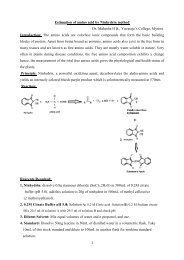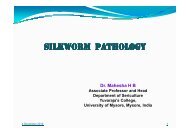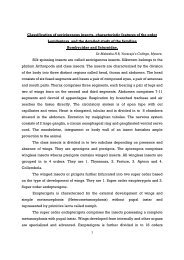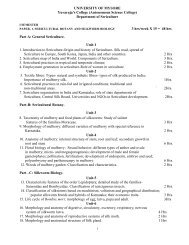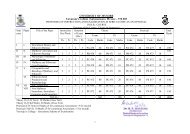silkworm grasserie and pebrine for open elective
silkworm grasserie and pebrine for open elective
silkworm grasserie and pebrine for open elective
Create successful ePaper yourself
Turn your PDF publications into a flip-book with our unique Google optimized e-Paper software.
Prevention <strong>and</strong> control: The fundamental measure <strong>for</strong> the prevention <strong>and</strong> control of this<br />
disease is to produce healthy eggs, so as to avoid embryonic infection. This can be achieved by<br />
conducting systematic mother moth examination. The other methods are to conduct effective<br />
disinfection of rearing rooms, equipments <strong>and</strong> surroundings <strong>and</strong> maintenance of strict hygienic<br />
conditions during rearing. It is essential to surface disinfect the layings in 2 percent <strong>for</strong>malin <strong>for</strong><br />
10 minutes be<strong>for</strong>e incubation. Such surface disinfection though practiced in grainages should be<br />
repeated again after release from cold storage as also by farmers. If the eggs are in advanced<br />
stage of embryonic development surface disinfection is done with 1 per cent <strong>for</strong>malin <strong>for</strong>5<br />
minutes. The room <strong>and</strong> equipments must be washed <strong>and</strong> disinfected be<strong>for</strong>e incubation.<br />
Young <strong>silkworm</strong>s should be reared under hygienic conditions. As a precaution test<br />
examination of unhatched blue eggs, dead eggs, hatched larvae <strong>and</strong> eggshells can be done <strong>and</strong> if<br />
<strong>pebrine</strong> is detected, such eggs should not be brushed <strong>and</strong> if brushed the larvae should be<br />
destroyed. Similarly predictive examination could be conducted by utilizing unequal larvae, late<br />
moulters, faecal matter <strong>and</strong> exuviae <strong>for</strong> the detection of <strong>pebrine</strong> spores. These tests may not<br />
only minimize the chances of rearing transovarially infected layings, but also check cross<br />
contamination <strong>and</strong> spread of the disease. Infected <strong>silkworm</strong>s, faeces <strong>and</strong> mulberry field pests<br />
are important sources of infection <strong>and</strong> should be properly disposed of to prevent cross infection<br />
<strong>and</strong> spread of the disease.<br />
During seed production in addition to mother moth examination, care should be taken to<br />
prevent contamination from other sources. The equipments used <strong>for</strong> one lot should not be used<br />
<strong>for</strong> the other till they have been thoroughly cleaned <strong>and</strong> disinfected. Eggs after surface<br />
disinfection should be dried <strong>and</strong> stored in a sepparate room away from egg production <strong>and</strong><br />
examination room.<br />
Besides, the above preventive/corrective measures, it has been reported that immersing of<br />
the <strong>silkworm</strong> eggs in hot water, high temperature treatment of the pupae, dipping of the eggs in<br />
hot hydrochloric acid minimize the incidence of <strong>pebrine</strong>. Chemotherapy of Nosema infection<br />
has been reported through a number of antimicrosporidian drugs like fumagillin, benomyl,<br />
bengard, bavistin, ethyl <strong>and</strong> methyl thiophanate <strong>and</strong> some of their analogues<br />
with positive results, but preventive methods have always been found to be better than the<br />
curative measures.<br />
--------------------<br />
8



